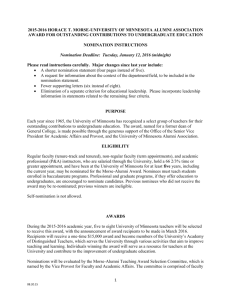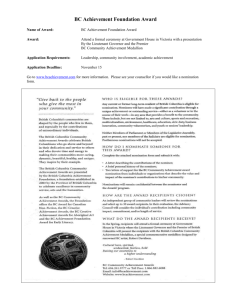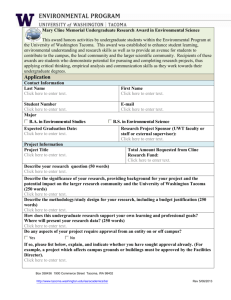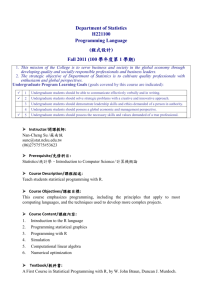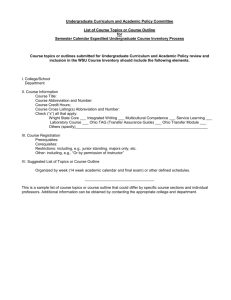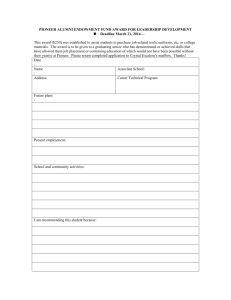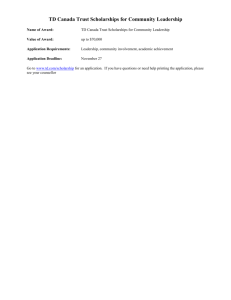NOMINATION GUIDELINES 2013
advertisement
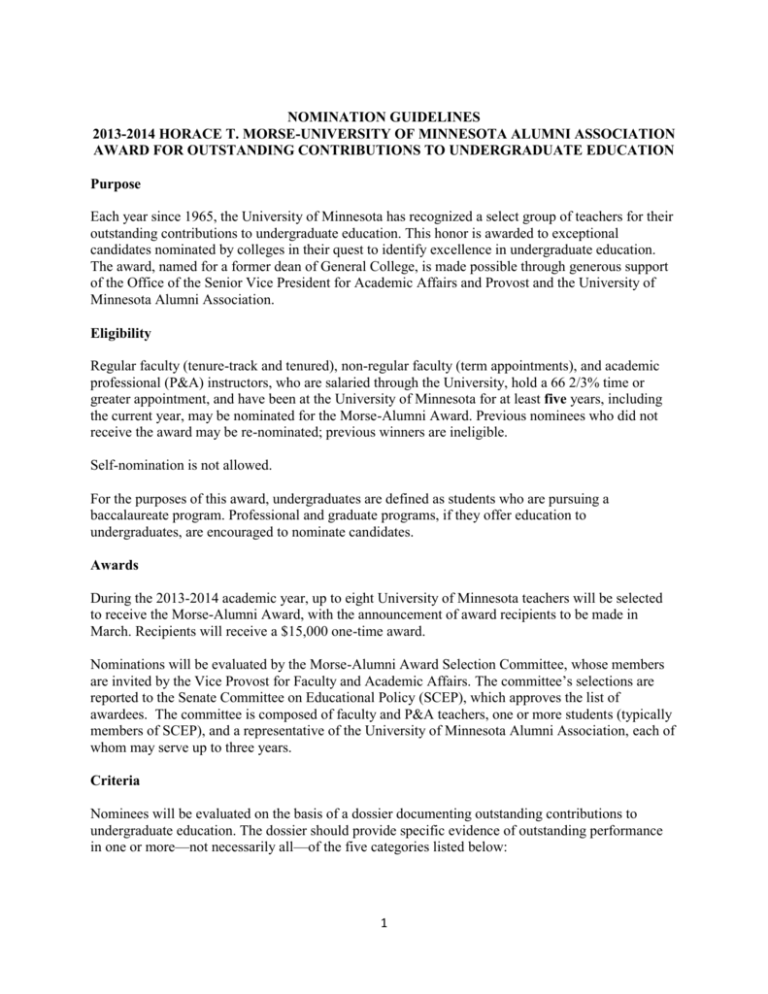
NOMINATION GUIDELINES 2013-2014 HORACE T. MORSE-UNIVERSITY OF MINNESOTA ALUMNI ASSOCIATION AWARD FOR OUTSTANDING CONTRIBUTIONS TO UNDERGRADUATE EDUCATION Purpose Each year since 1965, the University of Minnesota has recognized a select group of teachers for their outstanding contributions to undergraduate education. This honor is awarded to exceptional candidates nominated by colleges in their quest to identify excellence in undergraduate education. The award, named for a former dean of General College, is made possible through generous support of the Office of the Senior Vice President for Academic Affairs and Provost and the University of Minnesota Alumni Association. Eligibility Regular faculty (tenure-track and tenured), non-regular faculty (term appointments), and academic professional (P&A) instructors, who are salaried through the University, hold a 66 2/3% time or greater appointment, and have been at the University of Minnesota for at least five years, including the current year, may be nominated for the Morse-Alumni Award. Previous nominees who did not receive the award may be re-nominated; previous winners are ineligible. Self-nomination is not allowed. For the purposes of this award, undergraduates are defined as students who are pursuing a baccalaureate program. Professional and graduate programs, if they offer education to undergraduates, are encouraged to nominate candidates. Awards During the 2013-2014 academic year, up to eight University of Minnesota teachers will be selected to receive the Morse-Alumni Award, with the announcement of award recipients to be made in March. Recipients will receive a $15,000 one-time award. Nominations will be evaluated by the Morse-Alumni Award Selection Committee, whose members are invited by the Vice Provost for Faculty and Academic Affairs. The committee’s selections are reported to the Senate Committee on Educational Policy (SCEP), which approves the list of awardees. The committee is composed of faculty and P&A teachers, one or more students (typically members of SCEP), and a representative of the University of Minnesota Alumni Association, each of whom may serve up to three years. Criteria Nominees will be evaluated on the basis of a dossier documenting outstanding contributions to undergraduate education. The dossier should provide specific evidence of outstanding performance in one or more—not necessarily all—of the five categories listed below: 1 1. Teaching: direct contact with students in undergraduate courses and programs and in co-curricular activities. Teaching activities include instructing groups of students in classes, seminars, and laboratories; and supervising individual activities, such as practicums, internships, field-learning experiences, tutorials, performances, exhibitions, and independent study, including supervision of UROP projects. The activities listed above are representative, not exhaustive. 2. Advising: activities that aid individual students with course and major selection, career plans, and personal development, especially in ways that go beyond formal curricular advising; and those that provide guidance to student organizations or groups. Documentation should include information about accessibility to students, which ordinarily includes but is not limited to office availability.1 3. Research and Artistic Activities: such activities should be documented and discussed in terms of the relationship between these activities and the nominee's contributions to undergraduate education. 4. Academic Program Development: such activities that contribute to the planning, design, or development of improvements in undergraduate education. Contributions in this area include, for example, new courses or a cluster of courses, general-education options in the undergraduate curriculum, and valuable programmatic innovations of any kind. 5. Educational Leadership: extra-programmatic activities of any kind and at any level that constitute leadership and contribute substantially to undergraduate education; for example, presenting papers, holding a position such as national or regional officer or program chair in a professional association, or being a member of a college or all-University committee. This list should not be considered exhaustive or restrictive. The selection committee will consider any and all outstanding contributions to undergraduate education described by the materials provided. The committee will consider that some faculty also teach postbaccalaureate, graduate, and/or professional courses, and this contribution to other than undergraduate teaching should also be taken into account in weighing the strengths of candidates. The magnitude of an outstanding contribution in one area may compensate for little or no contribution in other areas. For example, not all distinguished classroom teachers have the opportunity to contribute to "academic program development" that persons in administrative offices do, but they may, nevertheless, make outstanding contributions to undergraduate education. The selection committee will consider outstanding contributions ranging from broadly distinguished performance over many years to a single extraordinary contribution without favoring one kind over another. Persons receiving awards will be those whose contributions to undergraduate education the selection committee considers the most outstanding in a given year and also genuinely outstanding regardless of the year or the competition. Selection of College Nominees Each college (or campus) engaged in undergraduate education may submit up to three nominations. Because of its size, the College of Liberal Arts (Twin Cities) may submit up to six nominations. Colleges may nominate teachers in other colleges as well as their own. 1 Where advising is the exclusive or primary contribution, a candidate should be nominated instead, or perhaps in addition, for the John Tate Award for Undergraduate Academic Advising. 2 The college should submit an online dossier to the appropriate NetFiles folder by no later than midnight (11:59 p.m.) on Monday, January 13, 2014. The NetFiles link has been provided to each college’s contact. Because each college may only submit a limited number of nominations, many colleges have an internal selection process to choose their nominees, and therefore, have an internal deadline prior to the University-wide deadline. Each college has a designated college contact for the Morse Award; departments, faculty, and students interested in submitting a nomination should contact their designated contact for information about the college’s internal selection process and deadlines. A link to the list of designated college contacts is available on the nomination information page (http://z.umn.edu/morsealumni). Successful dossiers will be made available for public review and various University of Minnesota editors may publish information from these dossiers in materials regarding the Morse-Alumni Award. Dossier contents will be publicly available except for information covered by the MN Data Privacy Act. Private or personal materials should not be included as part of the dossier. Organization and Presentation of Dossiers The following guidelines apply to the dossiers that are submitted to the Provost's Office for the University-wide competition. Because the processes by which colleges select their nominees vary significantly, those preparing dossiers at the departmental level should contact their designated college contacts to determine what materials are required for the internal selection process. In order to maintain a similar format and appearance among dossiers, online templates are provided for dossiers selected by colleges for submission to the University-level competition. Dossiers MUST be prepared using the templates provided; dossiers prepared with other materials will not be accepted. This policy has been implemented at the specific request of the selection committee to facilitate the review process. Each dossier should be submitted by the designated college contact to the established NetFiles folder. Sample dossiers are available for review at https://netfiles.umn.edu/xythoswfs/webui/_xye15726293_1-t_oAJWCh1m. Photographs, videos, and other types of visual materials not central to the dossier are discouraged. Brevity is encouraged in assembling the following materials. Items should be presented in the order listed below. A nomination form must be completed and submitted for each candidate. A link to this can be found at http://z.umn.edu/morsealumni. For items (a) through (g) below, templates are available for downloading from the Morse-Alumni Award website: http://z.umn.edu/morsealumni. Once created, each of these documents should be saved as a PDF in the designated NetFiles folder. Instructions for accessing the NetFiles folders will be sent out separately to the college contacts. To download a template, click on the link. A Microsoft Word document will open. Go to the “File” menu and click “Save As” to save the document to your computer. Click on the appropriate fields to enter your data. Templates may be emailed to those who will complete the materials, or they may be accessed directly from the website. 3 The fonts and spacing of the templates are set to conform to the specifications set forth in the guidelines below. The top margin of each template may be increased to accommodate letterhead, if necessary; please do NOT change any other formatting specifications. Please also note page and word count limitations specified below. All dossiers must include the following (in this order): a. Summary: Name as the nominee wishes it to appear on the award certificate, Scholars Walk, and in any publicity, should they receive the award (e.g. Kim A. Jones) and a 75-word summary of the nominee’s accomplishments relative to this award, written in the third person. b. Nomination Statement: A statement of no more than five pages (using a 12-point font, one-inch margins, and 1.5 line spacing)*, presenting the full case for the nomination as well as summarizing the dossier, with specific reference to the criteria listed in these guidelines. This statement forms the basis of the nomination and is extremely important for the review process. The author should describe the nominee's qualifications and other relevant criteria, focusing on specific details. The aim of this statement is to set out a convincing and detailed case for the nominee's outstanding contributions to undergraduate education. c. Candidate’s Personal Statement: Personal statement by the candidate of no more than 1,200 words (using a 12-point font, one-inch margins, and 1.5 line spacing) addressing the criteria for the award and the impact on student learning. d. Candidate’s Curriculum Vitae: The candidate's curriculum vitae of no more than four pages(using a 12-point font, one-inch margins, and 1.5 line spacing), organized according to the following rubric: • Education • Courses Taught at the University of Minnesota (include courses at all levels) • Program and Curricular Development • Service • Outreach and Other Activities Related to Teaching/Learning • Publications (a summary list of the candidate's most important published works). e. Teaching Evaluation Data: For undergraduate courses taught at the University of Minnesota over the previous five years of active teaching, provide a numerical overview compiled from student evaluations, arranged according to the form supplied. For upper division courses please specify the percentage of undergraduates enrolled. Up to one additional page of assessment of student learning can be included. f. Supporting Letters: Up to eight supporting letters, three of which must be from individual undergraduate students, past or present. The remaining letters may be from students, faculty, administrators, staff, alumni, or non-University of Minnesota references. In all cases letter writers are encouraged to cite specific examples in support of the case. g. Release Form: to download, go to http://z.umn.edu/morsealumni and look under the “To be included in online dossier submission” section for the release form. Additional information will not be considered. NOTES: Please retain a copy of the dossier at the collegiate or departmental level for your records. 4 The 2014 Distinguished Teaching Awards ceremony is scheduled for April 14, beginning at 4:00 pm. Additional Instructions for Designated College Contacts Designated college contacts should inform departments, faculty, instructional P&A staff, and students of the college’s internal selection process well in advance of the internal deadline, in order to ensure adequate time for dossier preparation. All colleges, small as well as large, are encouraged to have nominating committees to oversee the process and review nominations. As noted above, the designated college contact must complete the nomination form and then submit the dossier online in the designated NetFiles location. Designated college contacts will work with Chris Bremer (612-625-6176 or breme006@umn.edu) as needed to coordinate this process. 5
